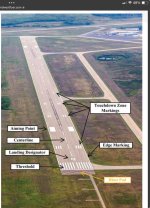PilotjohnS
Well Known Member
I currently fly out of a towered airport with instrument approaches.
The runway has a VASI showing glide slope with colored lights.
I have been using the VASI on landings out of habit, but it seems to set me up for a touch down a ways down the runway. Then the controller jumps on the radio asking me to expedite turn off.
But I kind of set him up for failure because I invariably get handed off to tower from flight following 20 miles out while I am doing 130 Kts. But at 5 miles out, I am in approach mode with flaps down doing 65 Kts (RV9a). So buzzing in at 130, then 65 on final; Cessnas dont do this.
I tried to avoid jamming on the brakes to save the pads ( since I am paying for them now), but then I run long and wont make the recommended turn off.
So do y’all land on the numbers, or 1000’ down on the offical “ touchdown” point?
The runway has a VASI showing glide slope with colored lights.
I have been using the VASI on landings out of habit, but it seems to set me up for a touch down a ways down the runway. Then the controller jumps on the radio asking me to expedite turn off.
But I kind of set him up for failure because I invariably get handed off to tower from flight following 20 miles out while I am doing 130 Kts. But at 5 miles out, I am in approach mode with flaps down doing 65 Kts (RV9a). So buzzing in at 130, then 65 on final; Cessnas dont do this.
I tried to avoid jamming on the brakes to save the pads ( since I am paying for them now), but then I run long and wont make the recommended turn off.
So do y’all land on the numbers, or 1000’ down on the offical “ touchdown” point?
Attachments
Last edited:





